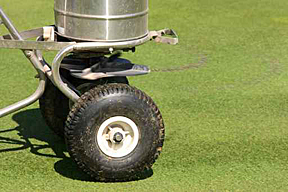
You can purchase fertilizers at the nursery or any home improvement store. Fertilizer packages give the nutrient ratio inside. You will see three numbers, such as 23-7-7 or 6-3-0. The first number is the concentration of nitrogen (for greening and leaf growth), the second is phosphorous (for building up the root), the third is potassium (to stimulate healthy growth and weather tolerance). The best rule of thumb for lawn fertilizing is to purchase a ratio with at least twice the nitrogen as the other nutrients (ex. 6-3-0). It is also recommended to buy a fertilizer with at least part of the nitrogen content in an immediate release form, and part in a slow-release form. Fertilizers are available with weed control already added in. This is perfectly acceptable to use. Follow the instructions on the package. If you buy fertilizer with the intent to save for a future date, be sure to store it away from moisture.
An established lawn generally only needs to be fertilized in the spring and in the early fall. Fertilizing too late in fall will do more harm than good. It encourages new growth which will be damaged by the cold if the new growth hasn’t had a chance to establish in the ground well. And, like the fall, fertilizing too early in the spring will also be damaging.
Spread your granular fertilizer the same as sowing seed. Using a spreader is recommended. A drop spreader is good if you are diligent to keep straight lines and make sure to walk at a steady pace. A broadcast spreader is easier so you can avoid missed spots. Follow the directions on the package as to what setting to use on your spreader. If it hasn’t rained two days after fertilizing, water the area to help adhere the granules to the ground and active the fertilizer.